#evolutionary tree
Text
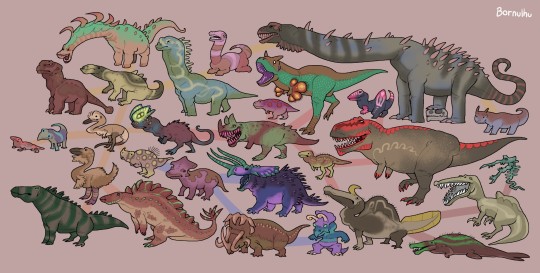
Wacky Evo chart but with dinos only
#creature design#creature#dinosaurs#colorful critters#colorful dinosaurs#speculative evolution#evolutionary tree#sauropods#ceratopsians#spinosaurus#bornulhu art
181 notes
·
View notes
Photo

https://arxiv.org/pdf/2304.13712v2.pdf
67 notes
·
View notes
Link
uDance, a novel method that builds highly accurate and scalable phylogenetic trees using the divide and conquer approach, has been devised jointly by scientists from the University of California, San Diego, and Arizona State University. Phylogenetic trees are like family trees for all living organisms that help us comprehend how different species are related to each other through evolution. The previous methods presented the drawbacks related to inaccuracy and inefficiency in handling large numbers of organisms. uDance, however, refines different parts of a phylogenetic tree independently and can also build off existing trees. Scientists implemented uDance and successfully generated a tree for around 2,00,00 genomes using 387 marker genes and a huge amount of amino acid data with enhanced accuracy and scalability.
The vast array of species on our planet translates into a large quantity of genetic material to investigate. There exist two methods, one emphasizing numerous genes and fewer organisms, and another focusing on a smaller number of organisms and more genes. The objective is to accumulate a plentiful supply of genes as well as numerous living organisms.
To achieve this goal, scientist Siavash Mirabab and his team have come up with uDance. The divide and conquer strategy employed by uDance breaks down the task into smaller parts and then merges them to build the family tree. This approach not only allows for efficient analysis of a massive amount of genetic data but also enables the updating of the tree as more and more data becomes available.
uDance was successful in creating a family tree for over 1,99,000 organisms using 387 marker genes while being computationally efficient which is a substantial improvement compared to previous methods.
Continue Reading
25 notes
·
View notes
Text
Studies of mitochondrial DNA suggest the Strepsirrhini suborder, containing the ancestors of Madagascar's lemurs, diverged from our own Haplorhini suborder approximately 64 million years ago, which implies that a common ancestor was present before this time, but not a great deal earlier.

"Human Universe" - Professor Brian Cox and Andrew Cohen
#book quotes#human universe#brian cox#andrew cohen#nonfiction#mitochondrial dna#strepsirrhini#madagascar#lemur#haplorhini#evolutionary tree#evolutionary history#hominids#platyrrhini#catarrhini#cercopithecoids#hominoids#hylobatids#spider monkey#macaque#proconsul#siamang#sivapithecus#gibbon#orangutan#ouranopithecus#dryopithecus#gorilla#chimpanzee#human
0 notes
Text
Predatory Bananas: an Evolutionary Horror
(Pls read, I literally spent HOURS on this <3)
A friend sent me the following video about the various potential methods of banana locomotion. It got me thinking. How would a banana move? Naturally, as an autist with a special interest in evolutionary biology, I took the joke a little too far and wrote a whole piece on the matter, analyzing the feasibility of each method and the changes they’d need to evolve in order to achieve them.
(Video courtesy of Burning Onion Animation on TikTok, they make great content, go check them out)
The first and most likely way bananas would move is if banana trees evolved to spread their seeds through their fruits rolling down hills like the morphology of #1 suggests. The only major mutations that need to happen are a more pronounced curve and increased rigidity to facilitate rolling and absorb the impact from falling from the tree. Overall, evolving to this point is relatively straightforward. #1 is the most feasible and realistic answer.
For bananas to develop motility like in #4 is theoretically possible with the right environmental pressures and with enough time, though much more difficult. I see this working in one of two ways. First, they could evolve rigid structures that change shape depending on moisture content, using natural dry/wet cycles to move a little more each time it rains, much like the seeds of Erodium Cicutarium (pictured below). The fruits of the banana tree would most likely evolve to have hooks on the end of said structures, contracting and pulling themselves forward a little each time they dry out, and relaxing and resetting their grip on the soil each time they get wet.
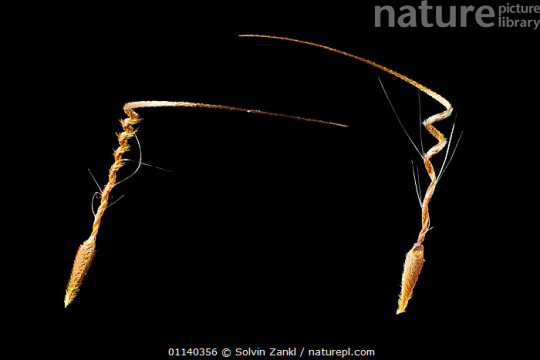
The second way I could see this happening is if they evolved true locomotion. True locomotion in bananas would take at least a few million years to evolve (probably more like tens of millions), and even then, movement would be incredibly slow. There exists a plant called the “walking palm” (socratea exorrhiza, pictured below) that’s capable of “walking” using its roots, but it can only travel about 20 meters per year in ideal conditions, and has the resources of the entire tree at its disposal, not just that of a single fruit.
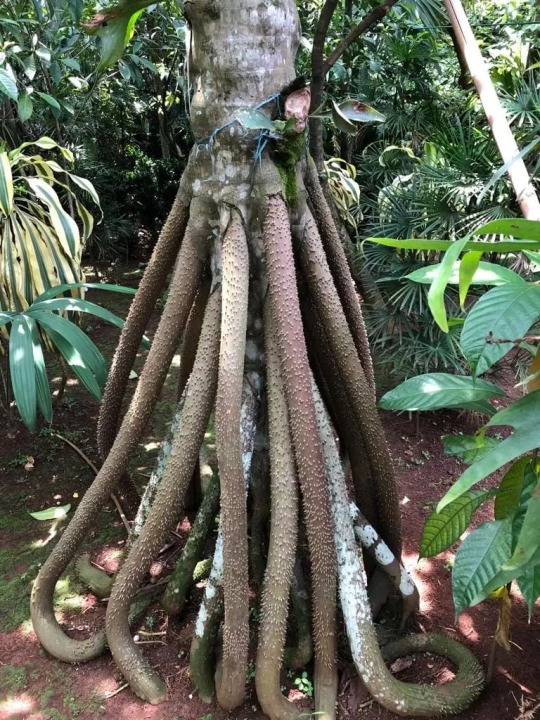
While this is the more likely explanation as to how #4 might happen, it’s not what the video depicts. The video clearly shows a banana dragging itself along like an inchworm, indicating motor cells such as those present in Dionaea Muscipula (venus flytrap, pictured below). Whenever this type of movement in plants occurs, it takes an extreme amount of energy and is generally rather inefficient and slow. In addition to this, the banana is moving its entire mass every time, so it’ll have to move much more slowly to compensate. This means that the banana would probably only be able to travel a few centimeters before decomposing beyond the point of functionality. After a few million more years it’s possible that bananas could evolve to travel as far as several meters after falling off the tree, but the further they go, the more fit each individual fruit needs to be, and the more energy and resources they need. Eventually, it’ll reach a point where the energy expenditure will outweigh the benefit and the fruits will stop evolving to travel any further, which I imagine would plateau somewhere in the 0.5 to 3 meter range. However, the fruits still require a significantly higher amount of energy at this point because they’ve evolved to move autonomously, so trees would likely evolve to produce fewer, but more developed fruits as a result. Overall this is the second most likely way bananas would evolve to move, but the video depicts a time lapse, not footage taken in real time.
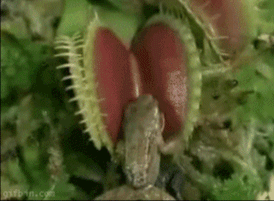
The next most likely option is #2, which is where things start to get much more interesting. At this point we are quickly beginning to leave the territory of the banana being a fruit and stepping closer towards the realm of the banana being its own independent organism. Whether the banana is still a single fruit from a larger tree depends on if the video is stabilized or not. First, let’s assume that the video has automatically stabilized the banana within the frame. This means that the banana is moving erratically and aimlessly, with the goal of simply moving as far from its origin as it can. The most simple form of this would be a ballistic dispersal method in which the banana grows curved and under tension, falling off the tree when ripe. Upon impact, the tension is released and banana extends, springing itself upward and outward with a single bounce. But this isn’t what the video shows either, it depicts clear and repeated movement, again suggesting the presence of motor cells much like those likely found in banana #4. In this case it probably evolved in roughly the same way as banana #4, but works less effectively due to having a less stable method of traveling.
But what if the video ISN’T stabilized, and the banana’s staying upright all on its own? In the video, the banana isn’t just moving along a single plane with one set of motor cells like the Venus flytrap. It’s full on galloping. This requires multiple groups of motor cells working together in a coordinated effort. This banana has real-time sensory input to orient and stabilize itself. This means that the banana has evolved some sort of internal gyroscope, much like our inner ear that helps it determine what up and down is, and more importantly, angular rotation. While plants have been observed reacting to and even predicting stimuli in ways that still baffle scientists to this day, this is far more complex than any plant every discovered throughout human history. Everything here points to something more, perhaps rudimentary intelligence, dare I even say sentience.
This begs the question: is it even a plant anymore? At this stage it’s evolved sensory organs and can move independently. But why? Organisms don’t evolve the ability to move without reason. This could mean one of three things. First, it could have evolved the ability to run as a means of spreading its seeds further. But this can’t be the answer. Moving more slowly would be way more efficient for a banana in terms of energy expenditure, and spreading seeds the old fashioned way is still perfectly viable, so it wouldn’t have evolved that way due to lack of necessity. This brings us to the first legitimate possibility: the banana is prey. If the banana were prey, then the ability to gallop most likely evolved as a means of escaping predators and to avoid being eaten. This is further evidence that the banana has evolved beyond being a humble plant as this goes completely against the purpose of fruits, which evolved to be eaten on purpose. Now, the banana’s goal isn’t to be eaten so that its seeds may be deposited elsewhere, its primary objective is to survive. At this point it’s relatively safe to assume that the banana no longer comes from a tree, and now reproduces through fragmentation, or perhaps even live birth. Its lack of leaves suggest that it’s evolved beyond being an autotroph and relying on photosynthesis. But if it no longer gets nutrients from a tree, how does it subsist? It must be getting its energy from somewhere. The most likely answer to this is that banana is a herbivore, and gets its energy from plant matter, which contains a lot of the same nutrients that the banana recently used to get by growing on a tree. Overall, this is the third most likely way the banana would evolve locomotion.
But what if it isn’t an herbivore? This brings us to the other possibility: the banana is a predator. The banana that concerns me the most is banana #3. While all the other bananas have undergone major changes to their morphology, banana #3 appears to be identical to any regular banana, yet it still moves. The only way that such movement could be possible is if the banana had some sort of internal mechanism that moves its center of mass around rather quickly within its outer shell, which also requires an internal gyroscope for balance. I know what you’re thinking; “but this is an incredibly complex mechanism, wouldn’t it be easier to evolve one of the other ways?” To which the answer is yes, it would. But this raises another question with an even more alarming answer: why didn’t it? The answer lies in the banana’s identical appearance to that of a typical Cavendish. Clearly, looking like an ordinary banana is central to its survival strategy. At this point, it’s evolved well past the point of being a fruit and has become the first of an entirely new kingdom of sentient creatures descended from plants.
According to my estimates from the video, banana #3 is only able to move at a pace of around a tenth of a meter per second, maybe a quarter or half of a meter at the most. This means that it probably didn’t evolve the ability to move as a means of running from predators. Based on the physics in the video, my best guess as to how the banana moves is through the use of mostly hollow internal chambers with a central mass (probably a calcified seed) suspended by tendons that can move in any direction, accelerating the banana in that direction. Here I’ve collaborated with the massively talented @pholidia to bring my ideas to light.

Picture it. You’re a lone banana farmer in South America. You’re out harvesting your crops when you see a single banana on the ground. It looks a little weird and bruised, but still totally edible. “No good in letting perfectly good produce go to waste” you think to yourself as you pick up the banana. You go to peel it when suddenly, you feel a sharp shooting pain through your hand. You drop the banana, then fall to your knees. You look around for the wasp or whatever it was that stung you, but you can’t find anything. You collapse in a heap on the ground, unable to control your body. It’s at this point you notice the banana start to move. “Are… are those teeth?” you think to yourself. At this point the venom has taken full effect. You are alone and completely paralyzed, unable to do anything besides observe the banana as it starts moving towards you. Sharp teeth and beady black eyes are fully visible now. It ambles towards you clumsily, moving almost as if it were being controlled by invisible strings like a marionette. It reaches you and starts to chew. It is at this moment that you discover, much to your horror, that the venom is merely a paralytic, and not an anesthetic. Helpless to the venom, you can do nothing but watch as your blood slowly drains out onto the ground as the creature consumes you. Slowly, your vision begins to fade to black. You pass out, either from the pain or the blood loss, you’re not really too sure. You take one last look at the creature, then you’re gone forever.
#biology#evolutionary biology#evolution#bananas#plants#darwin#science#botany#banana#r/196#196#r/196archive#/r/196#rule#meme#memes#shitpost#shitposting#autism#stem#cool#funny#plant#cooking#trees#fruit#unreality#joke#funny shit#funny post
216 notes
·
View notes
Text
I wanted to make a post with some links to explain why afforestation (planting trees to stop desertification; the change of environments into deserts) is not always the best approach to take.
So lately on social media there's been a lot of misinformation of like tree planting = always good. But the problem with this approach/view is it gives companies and governments the excuse to use forest monocultures (millions of one or few tree species) to fund logging industries instead of taking the time to develop an ecosystem of native plants.
(Link to real life example:)
youtube
Ecosystems undergo ecological succession where bare land is converted to ecologically productive (lots of different organisms with different roles in the ecosystem, nutritious soil) and biodiverse (lots of different species) land. It also takes a long time for this to happen.
See these:
youtube
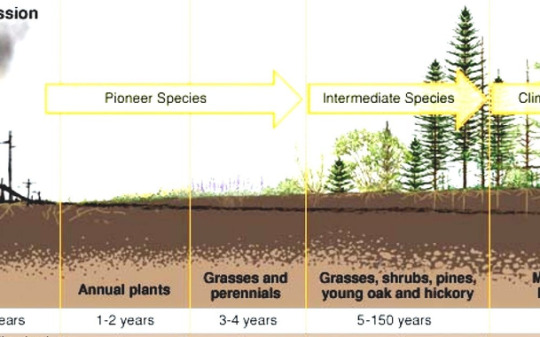
Here's some links a video explaining why just planting trees ultimately doesn't work in the long term if done wrong:
youtube
And here's some links to videos explaining how it can be done right when we actually look at the evolutionary history of the ecosystem and ecology of it and restore it using native species and less rigid attitudes.
youtube
youtube
youtube
youtube
youtube
Habitat restoration is a HUGE branch of conservation biology and is constantly causing disagreements in scientific communities because its a new science and there are so many different branches of biology (e.g. ecology, evolutionary history and ecology, geology, etc) we need to consider and so many old attitudes that need revising in some conservation techniques.
This is only a guide to trees alone in habitat conservation as well, there are so many different habitats other than forest that need to be conserved as well as forests, particularly wetlands which are so abundant in biodiversity and ecosystem services (things ecosystems can do for the world essentially, unfortunately the focus in research can be on what ecosystems can do for us).
I've also not looked much at how this has been done outside of official organisations and I wanna look more at conservation projects ran illegally but I'm bad at finding information lol
#wow i expressed an opinion online without panicking#now to bury my head in the sand if i get criticised#ecology#trees#tree ecology#conservation biology#habitat restoration#rewilding#wildlife#tree conservation#evolutionary ecology#mosscore#forestcore#forests#Youtube
2K notes
·
View notes
Text
I love when people apply their subjects of study/work to a narrow part of tes lore. One of my favorite parts of this fandom
#learn new things AND engage with special interest!! what could be better!!!!!#anyway shout out to that soil post#and to the food posts i see form time to time#there is a phylogenetic tree and evolutionary history of the morrowind/skyrim beasties in my head that i need to put into the world someday#also i have an idea for unique soul gem powered and dwemer sewing machines but im not good enough at designed machinery for that#mine#tes#the elder scrolls#tesblr
42 notes
·
View notes
Text
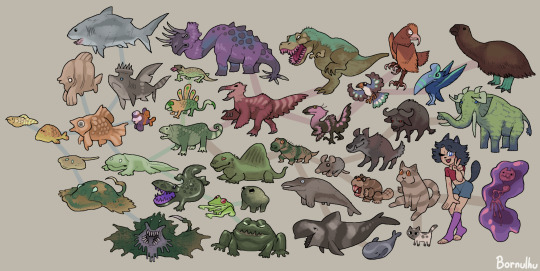
Wacky evolutionary tree
#creature design#monster design#original creature#evolution#speculative evolution#evolutionary tree#dinosaurs#catboy#colorful critters#bornulhu art
160 notes
·
View notes
Text
despite its name, cyclizar is not a lizard pokémon. it is actually an archosaur, most closely related to bird and crocodilian pokémon. its prehistoric ancestors are believed to have been feathered and capable of gliding, though this trait was lost over the millions of years of evolution that gave us our modern motorcycle buddies.
#pokémon#pkmn irl#cyclizar#koraidon#< kinda#[i do not know the exact evolutionary tree of archosaurs to place this thing further than this.]
29 notes
·
View notes
Text
petition to launch my sinuses into fuckin space
#what genius on the evolutionary tree thought#hey u know what will make a good overflow for when the sinuses are this congested?? THE INNER EAR!#aka im at the part of the cold where your whole head feels yucky#sick#man idk
208 notes
·
View notes
Text
"An international team of scientists have discovered a huge spike in radiocarbon levels 14,300 years ago by analyzing ancient tree-rings found in the French Alps.
The radiocarbon spike was caused by a massive solar storm, the biggest ever identified.
A similar solar storm today would be catastrophic for modern technological society—potentially wiping out telecommunications and satellite systems, causing massive electricity grid blackouts, and costing us billions of pounds.
The academics are warning of the importance of understanding such storms to protect our global communications and energy infrastructure for the future."
continue reading article
#sun#cycles#solar storm#solar energy#astronomy#space#solar system#earth#nature#trees#history#energy#radiation#earth atmosphere#radiocarbon#science#technology#discovery#evolutionary stages#electric universe
18 notes
·
View notes
Text

whats this guys deal
#i dont think its a native tree cause most aus native trees have evolutionary traits which help them absorb LESS sunlight#but the fact that this guys branches and leaves go straight up . like the branches fan out but then grow vertically#that seems like a trait to collect more sunshine#idk tho . idk
12 notes
·
View notes
Text
People, I am begging you to spell words properly. Folks is already fully inclusive, you don't need to turn it into "folx", this isn't twitter, we don't have a character limit. All it's going to do is inconvenience people with screen readers and probably dyslexic people too.
But a very special fuck you to the person I saw who wrote it as folques. Fucking stop. That one can't even be justified by twitter brain poisoning, since it's longer than just writing folks, you know the real word that already exists.
#yes yes language is constantly evolving#but this particular branch of the evolutionary tree needs to be trimmed ruthlessly lest it grow
243 notes
·
View notes
Text
do you ever fill a big bottle of water fully intending to drink it and hydrate and then completely forget about it and realize half a day later you did not drink any fucking water
#is this my nd curse#i forget the most basic of functions#like drinking water goes back and spans the entire eukaryotic evolutionary tree basically#and you mean to tell me i Forget. to drink. water!#the speaking clown
37 notes
·
View notes
Note
I can't remember which team they're playing in the ep with the yellow and blue kit, but football teams have a 3rd kit to wear if they are playing away and their away kit is too similar to the other team's kit so thats probably why we only saw that one once
Hello Nonnie!
Thank you so much for dropping this insight off in my inbox! The wildly talented and endlessly knowledgeable @abubblingcandle was just explaining this to me as well!
In my domestic football code, teams have a home kit, an away kit (which is usually just switching out the colour of their shorts lol), and only one clash kit- any further variations to the uniforms are either charity based or occasion specific, so the existence of that blue and yellow bonus clash kit from 3x07 was just very perplexing to me 🤣
Thankfully there are wonderful people like you and candle floating about on the internet to explain the fantastic chaos that is 'the world's game' to football-naive people like me!
💚💚💚
#i need to unleash random questions in the tags more often! I got two answers in under two hours#does anyone know the answer to life the universe and everything?#can someone teach me how to retain a second language?#do all humans have an innate desire to climb trees as an evolutionary remnant from when we were baby arboreal hominins?#THANK YOU AGAIN NONNIE!#ted lasso#ask box is always open
4 notes
·
View notes
Text
So I imagine Burning Leo would be related to Fire Lions (just more round), but I'm also wondering if they're related to Efreeti as well.
And if that's the case, Efreeti might also be a round fiery cat as well.
#zephyr speaks#Sometimes I think about evolutionary trees and how they would work in Dream Land#I know Efreeti is based moreso off a demon than a cat but still
2 notes
·
View notes